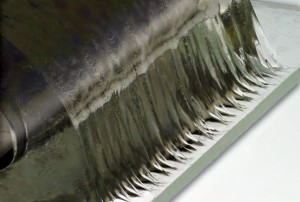MIT has developed a new and more efficient way to desalinate water. The process, called shock electrodialysis, filters water through a material made of small glass particles, according to an MIT News report. When an electric current is introduced to the system, the water divides into areas of high or low salt concentration. Once the current reaches a certain point, a shockwave is produced that divides the streams and allows the salty and fresh waters to be separated by a physical barrier. The process filters out other contaminants in addition to salt, according to MIT News.
Traditional desalination technologies, including reverse osmosis and electrodialysis, require barriers to separate out salt’s larger sodium and chlorine atoms. The new technique coaxes water to separate on its own, divided by an electric shockwave. “The salt doesn’t have to push through something,” Martin Bazant, professor of chemical engineering and mathematics at MIT, explained in a press release. Instead, the ions “just move to one side.”
Bazant is the lead author of a new paper on the process, published this week in the journal Environmental Science & Technology Letters. The new technology is rather simple. First, the water is guided through a porous material, a “frit” composed of tiny glass particles. The frit is sandwiched by electrodes, or current-carrying membranes. When the current is switched on, the flowing water begins to divide into two columns, one more salty and one less salty. As the electricity is revved up, a shockwave is generated between the two columns and the salt and non-salt water molecules separate entirely. A simple barrier can be used to divide the two columns from each other. “It generates a very strong gradient,” Bazant said.
Though the technology may eventually be scaled up, as of now, it’s not ready to compete with larger reverse osmosis and electrodialysis. But the less complex downsized and cheaper setup make it ideal for emergency use, like in the wake of a water quality-compromising storm, or in remote locations. It could also be used to clean and desalinize waste water generated by fracking. Right now, fracking operators struggle to find safe and effective places to store wastewater. “The electric fields are pretty high, so we may be able to kill the bacteria,” said graduate student Sven Schlumpberger, one of the paper’s co-authors.
The underlying phenomenon of generating a shockwave of salt concentration was discovered a few years ago by the group of Juan Santiago at Stanford University. But that finding, which involved experiments with a tiny microfluidic device and no flowing water, was not used to remove salt from the water, says Bazant, who is currently on sabbatical at Stanford. The new system, by contrast, is a continuous process, using water flowing through cheap porous media that should be relatively easy to scale up for desalination or water purification. “The breakthrough here is the engineering [of a practical system],” Bazant says.
One possible application would be in cleaning the vast amounts of wastewater generated by hydraulic fracturing, or fracking. This contaminated water tends to be salty, sometimes with trace amounts of toxic ions, so finding a practical and inexpensive way of cleaning it would be highly desirable. This system not only removes salt, but also a wide variety of other contaminants and because of the electrical current passing through, it may also sterilize the stream. “The electric fields are pretty high, so we may be able to kill the bacteria,” Schlumpberger says.
The research produced both a laboratory demonstration of the process in action and a theoretical analysis that explains why the process works, Bazant says. The next step is to design a scaled-up system that could go through practical testing. Initially at least, this process would not be competitive with methods such as reverse osmosis for large-scale seawater desalination. But it could find other uses in the cleanup of contaminated water, Schlumpberger says. Unlike some other approaches to desalination, he adds, this one requires little infrastructure, so it might be useful for portable systems for use in remote locations, or for emergencies where water supplies are disrupted by storms or earthquakes. Maarten Biesheuvel, a principal scientist at the Netherlands Water Technology Institute who was not involved in this research, says the work “is of very high significance to the field of water desalination. It opens up a whole range of new possibilities for water desalination, both for seawater and brackish water resources, such as groundwater.” Biesheuvel adds that this team “shows a radically new design where within one and the same channel ions are separated between different regions. I expect that this discovery will become a big ‘hit’ in the academic field. It will be interesting to see whether the upscaling of this technology, from a single cell to a stack of thousands of cells, can be achieved without undue problems.”
For more information please visit: www.mit.edu


Comments are closed.